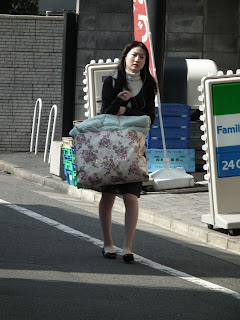Nasza ekscelencja zarządziła święto państwowe. Stąd gaijin korzystając z ładnej pogody oddał się swojemu ulubionemu sposobowi spędzania leniwych dni w Tokyo - ruszył przed siebie - bez mapy, bez planu i pomysłu - tam gdzie go nogi poniosą. Macie dzisiaj okazję zobaczyć Tokyo jakie rzadko kiedy dociera do gaijinskich oczu. Z dala od wielkomiejskiego pośpiechu, tłumów i samochodów. Tokyo pachnące suszącym się praniem, gotowanym obiadem i świeżymi owocami morza wystawionymi na straganie. Tokyo wąskich uliczek i zakamarków, małych lokalnych społeczności, bez wieżowców, nowoczesności a za to z małymi sklepikami, straganami i zwykłymi mieszkańcami tego niezwykłego miasta. Tak wygląda prawdziwe Tokyo. Dostępne dla każdego - trzeba tylko umieć i chcieć zabłądzić.
The Long Review of 2025: Pt II
9 godzin temu


















Uwielbiam takie wpisy - pokazujące codzienność tę mniej i bardziej szarą. :) Mam nadzieję, że i mnie uda się trochę tej japońskiej codzienności zagarnąć. Zostało 20 dni. :D
OdpowiedzUsuńNastępnym razem proponuję Ci przejażdżkę tramwajem linii Toden Arakawa z Wasedy, 40 minut między najzwyklejszymi domami mieszkalnymi i codziennymi ludzkimi sprawami.
OdpowiedzUsuńI love everyday life pictures too. Maybe some pictures of the suburbs? There was a nice article in Gazeta Wyborcza last weekend about a Polish architect working in Tokio. The article was great but not enough pictures :)
OdpowiedzUsuńChris, it is hard to define the suburbs in Tokyo. Take a look at this picture :)
OdpowiedzUsuńEverything that is not green looks like on the pictures above. It doesn't really matter if you're 1 or 50 km from the city center - which in Tokyo...does not exist as such. There are many "city centers" scattered around the main railway ring - the Yamanote line - which makes it even more complicated. Soo....I would say that, yes, these are the suburbs ;)
But kubala, those are not the 'burbs, not even close. Once when you start seeing the new subdivisions with identical cookie cutter (don't know what to call them, but def not McMansions - way too small for that) structures, right angle streets and mini-strip malls anchored to one big grocery store, then you know you're in the suburbs. But for that you'd have to go all the way to Saitama or Chiba, get off the train and then walk for another 30 minutes.
OdpowiedzUsuńdwakoty! For heaven's sake - I'm trying to play wiseass here and you're ruining everything! :P
OdpowiedzUsuńWe are starting to get the cookie cutter estates here in Poland as well and hee, hee I live near one such mini-strip mall with a grocery - it's not the quaint old town or bustling city center but it is so gosh darned convenient. The 'burbs, however, have got nothing except maybe the occasional Żabka convenience store.
OdpowiedzUsuńAfter a 4-hour bus ride on the interstate highway in America, my husband said that it looks like we don't have small towns in America, only big cities, farmland and shopping malls ;)
Is it true (from the article in Wyborcza) that Japanese houses in the suburbs can be tiny for ex 50 sq. meters and sometimes have a view straight onto another building?
I don't know how big the houses are (but since I have 19 sq. meters apartment, 50 sq. meter houses are possible) but yes - building are pretty close to each other.
OdpowiedzUsuńFew years ago someone from our office bought a house in Tokyo. He was soooo proud of that. House was pretty narrow (only one window in front) but was a 'walking distance' from Yamanote line (he was even more proud of that). After some time it turned out that walking distance means walking for 30 min. Probably, living in Wrocław's Gaj, I should be proud of that I live only a walking distance from our Market Square, haha.
BTW: On Sunday I'm going out of Tokyo so I hope I will make some suburb photos.